Key takeaways
- Equity in education requires recognizing individual student needs and dismantling systemic barriers rather than applying a one-size-fits-all approach.
- Principles such as responsiveness, accountability, and inclusivity are essential for creating an environment where every student feels valued and engaged.
- Personal reflection and challenging one’s biases are crucial for educators to foster an equitable learning environment.
- Strategies like differentiated instruction and community engagement can significantly enhance the relevance and effectiveness of education for diverse learners.
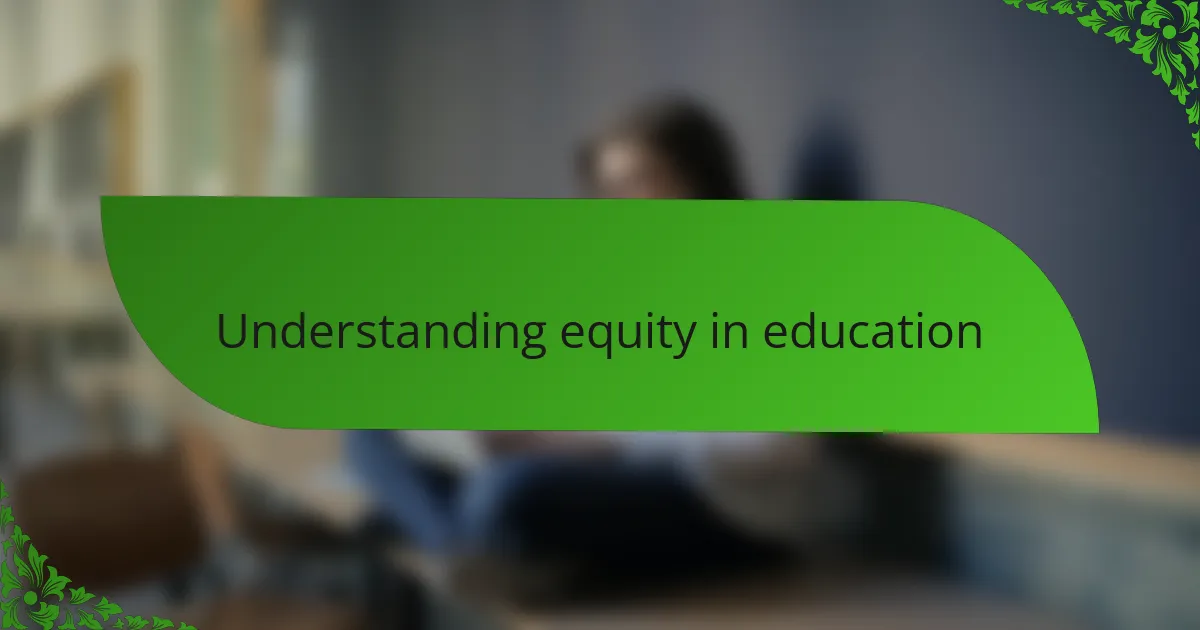
Understanding equity in education
Equity in education, to me, means meeting students where they are, not where we wish they were. I’ve seen classrooms where identical resources are handed out, yet the needs beneath the surface vary so widely it almost feels like teaching blindfolded. How can we claim fairness if some students must climb steeper hills just to reach the same summit?
Reflecting on Angela Davis’s work, I realize equity demands a deeper, structural change—a shift in how we view opportunity itself. It’s not just about access but about dismantling barriers that have historically marginalized voices and minds. I remember a time when a bright student from a disadvantaged background was overlooked simply because the system wasn’t designed to recognize their potential.
Isn’t it thought-provoking that true equity requires us to question our assumptions about ‘equality’ itself? I’ve come to believe that treating everyone the same isn’t enough; we have to be intentional, compassionate, and courageous in addressing the unique hurdles each learner faces. This realization transforms my understanding of education from a standardized process to an empathetic mission.
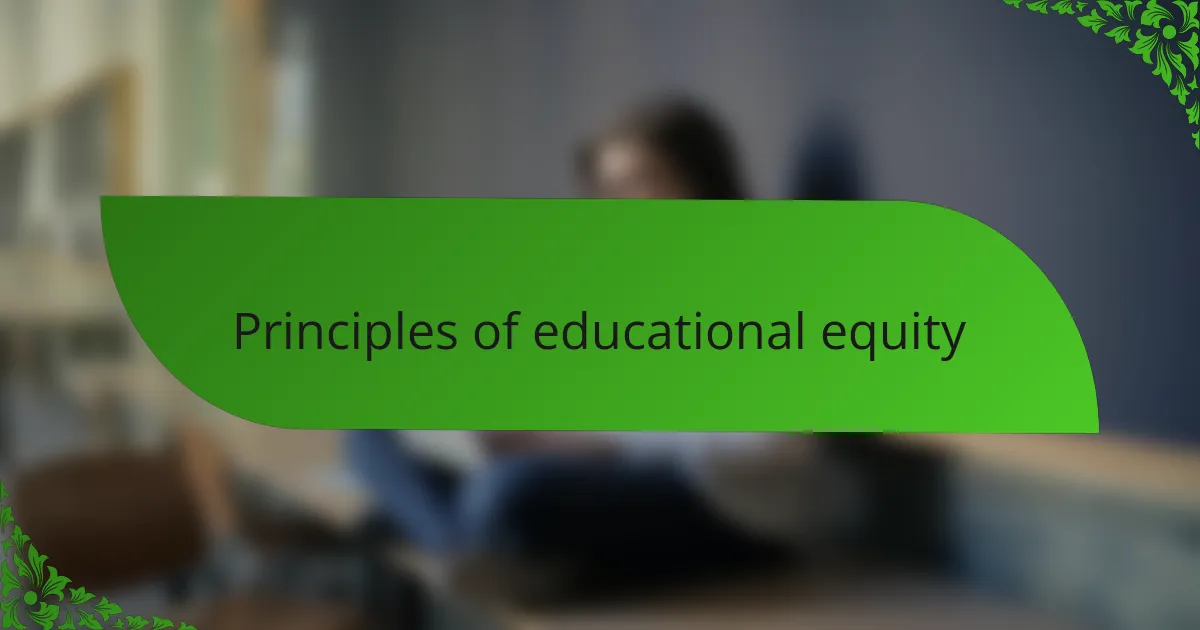
Principles of educational equity
When I think about the principles of educational equity, fairness immediately comes to mind—but not fairness as simply giving everyone the same thing. It’s more about recognizing that each student begins their journey from a different place, shaped by distinct challenges and opportunities. One principle I’ve learned to value deeply is responsiveness—adjusting support based on individual needs rather than relying on one-size-fits-all solutions.
Accountability is another key principle that stays with me. It’s not just about educators doing their job but about systems actively removing barriers that hold certain groups back. I remember a moment when a school initiative shifted focus to culturally relevant teaching, and suddenly, students who once felt invisible were engaging with fierce pride. Isn’t it striking how much equitable education depends on creating environments where every student feels seen and valued?
Lastly, inclusivity plays a crucial role in these principles. It’s about more than just physical access to schools—it means embracing diverse perspectives, experiences, and identities within the curriculum and community. I often ask myself, how can education be truly equitable if a student’s culture or voice is absent from what they learn? This question pushes me to advocate for spaces where every narrative matters because that’s where real learning—and real equity—begin.
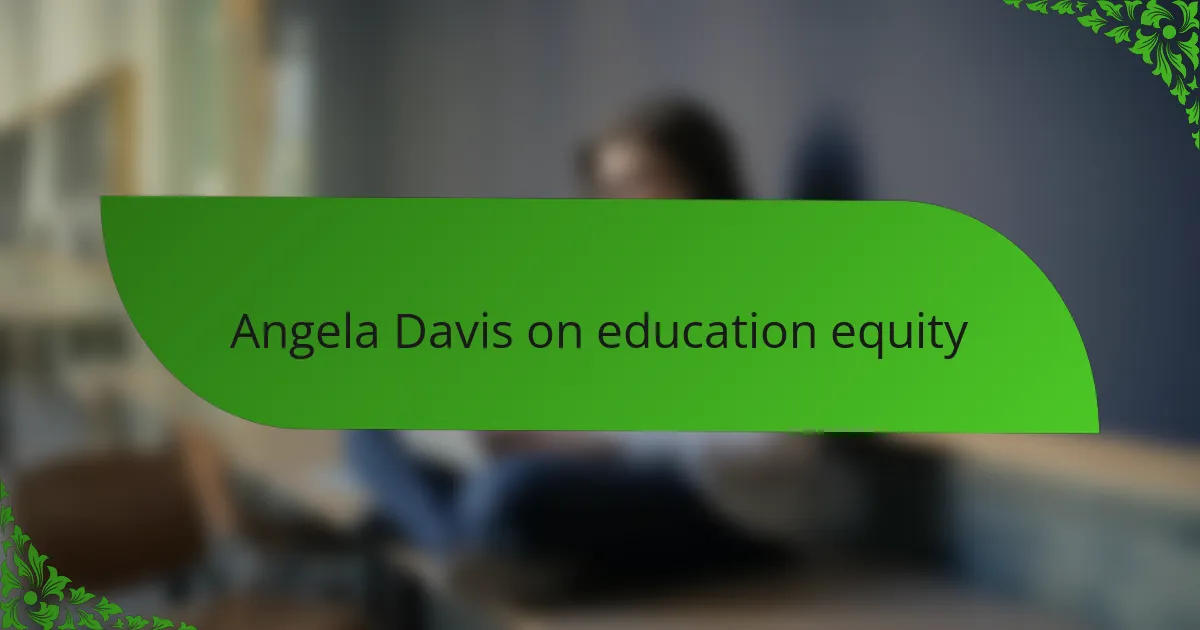
Angela Davis on education equity
Angela Davis’s perspective on education equity resonates deeply with me because she calls attention to the systemic roots of injustice rather than just its surface symptoms. She challenges us to see education not as a neutral arena but as a battleground where societal inequalities are often reproduced. Have you ever wondered why certain students consistently face obstacles that seem invisible to others? Davis pushes us to acknowledge these hidden barriers.
I recall a moment when I first encountered Davis’s argument that true educational equity demands revolutionary change, not reform. It reminded me of students I’ve taught who weren’t just struggling academically but were grappling with exclusionary policies that limited their growth. Doesn’t it make you question how much potential slips through the cracks when equity is treated as optional rather than fundamental?
What strikes me most about Angela Davis is her insistence on education as a tool for liberation, not just assimilation. She urges us to envision schools as spaces where marginalized voices are centered and empowered. This vision challenges me daily to rethink the curriculum and my own role in nurturing an environment where every learner can thrive, beyond just surviving.
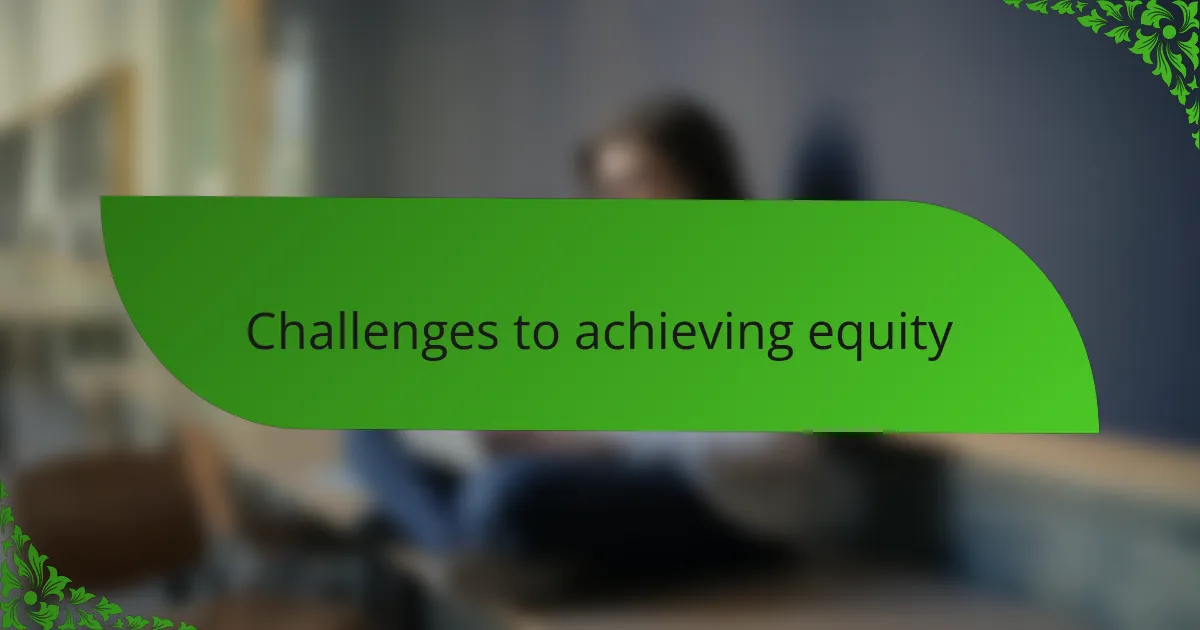
Challenges to achieving equity
One challenge I often wrestle with is how deeply ingrained biases influence who gets recognized and supported in education. I remember noticing how some students’ struggles were dismissed as personal failings rather than symptoms of a system stacked against them. How can equity thrive when the very people meant to uplift learners sometimes unknowingly perpetuate exclusion?
Another hurdle lies in the unequal distribution of resources—not just materials, but also time, attention, and emotional support. I’ve seen schools where underfunding creates invisible cracks that widen the gap between students from different backgrounds. Doesn’t it feel frustrating that despite good intentions, these structural limitations keep fairness just out of reach?
Then there’s the challenge of changing minds and hearts, which might be the hardest barrier of all. I’ve found that some resistance to equity stems from discomfort with confronting uncomfortable truths about privilege and oppression. How can we expect meaningful change if we shy away from the honest conversations that equity demands? This tension reveals that achieving equity is as much a social and emotional journey as it is a policy one.
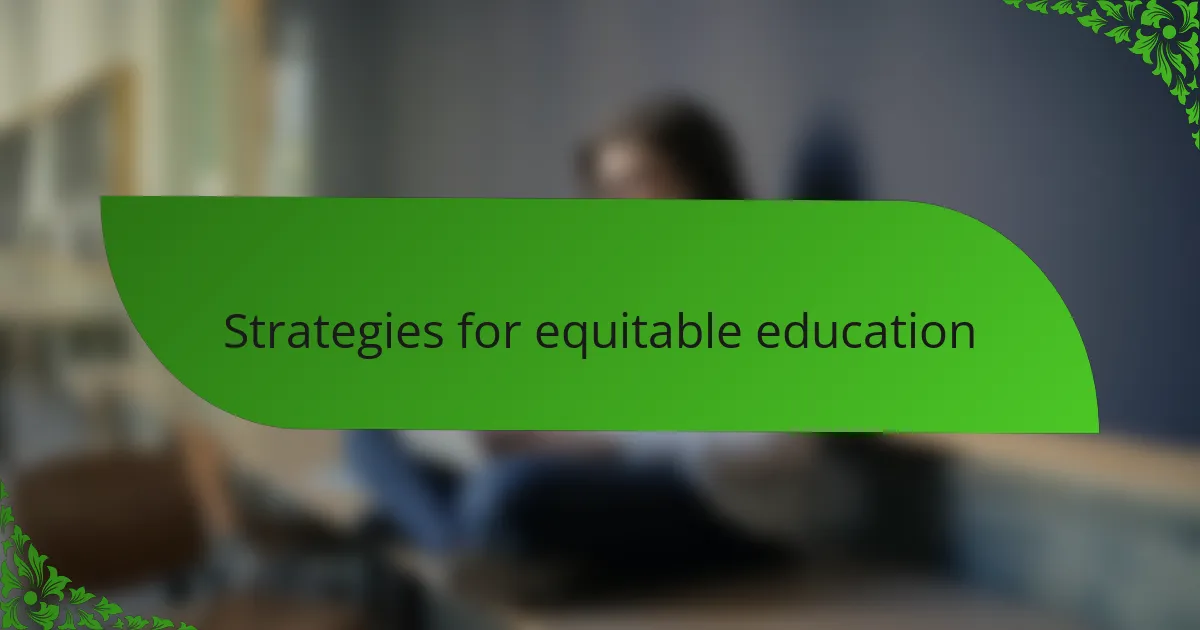
Strategies for equitable education
When I think about strategies for equitable education, differentiated instruction comes to mind first. I’ve seen how tailoring lessons to individual learning styles and backgrounds can unlock potential that a standard lecture simply misses. Isn’t it remarkable how a small adjustment—like flexible grouping or varied assessments—can make a student feel truly understood?
Another strategy that resonates with me is community engagement. When schools actively involve families and local voices, education becomes more relevant and empowering. I recall a project where students collaborated with neighborhood leaders, and suddenly, learning wasn’t confined to textbooks; it was alive and connected to their realities. How often do we underestimate the power of including community perspectives in shaping education?
Finally, professional development focused on equity has been a game-changer in my experience. Teachers need ongoing training that challenges their biases and equips them with tools to address systemic inequities. I remember attending a workshop that shifted my thinking from seeing challenges as deficits to recognizing them as calls for change. Doesn’t investing in educators’ growth ultimately shape a more just and compassionate classroom?
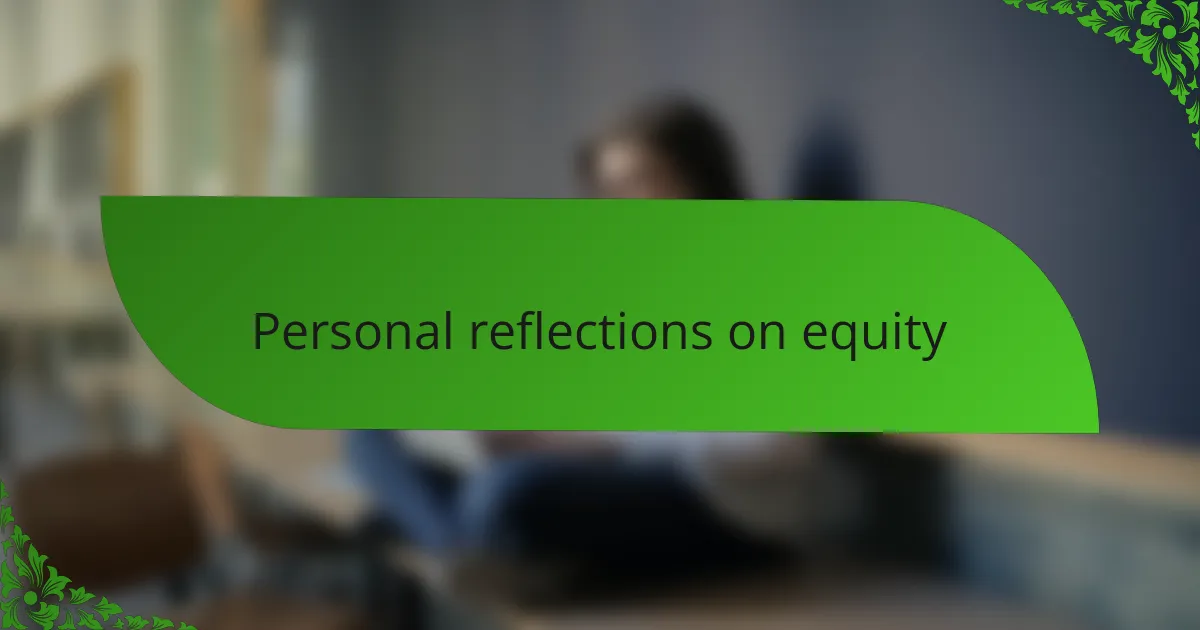
Personal reflections on equity
Equity in education feels intensely personal to me because it highlights gaps I’ve witnessed firsthand—moments when a student’s brilliance was dimmed not by lack of ability but by unmet needs. Have you ever noticed how a simple adjustment or a bit of understanding can change a student’s entire day or even life trajectory? That realization keeps me hopeful but also deeply aware of how much work remains.
Sometimes, I find myself wrestling with feelings of frustration and urgency. It’s heartbreaking to think about the talented young minds sidelined by circumstances beyond their control. Isn’t it almost painful to admit that despite our best intentions, the system often fails to catch those who fall between the cracks?
Yet, I also feel a sense of responsibility and commitment. Every time I reflect on equity, I’m reminded that it’s a continuous journey—one requiring patience, empathy, and steadfastness. What if we all embraced this mindset? How different would education look if each of us took personal ownership of dismantling barriers rather than accepting them as immovable?
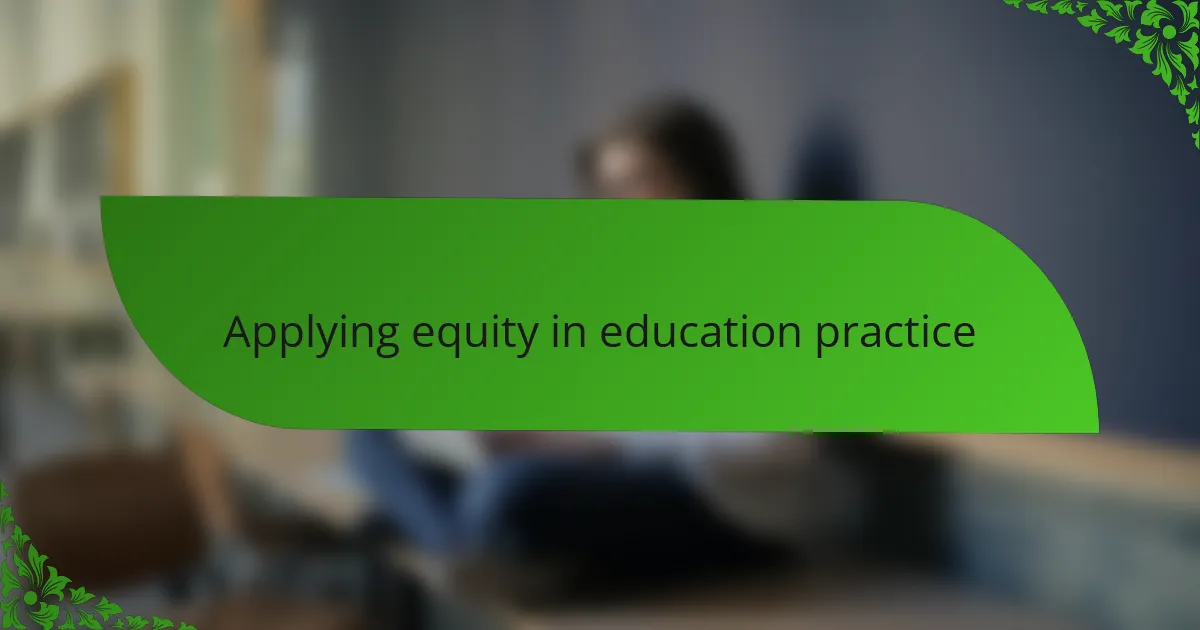
Applying equity in education practice
Applying equity in education practice means more than tweaking lessons—it calls for a deep commitment to understanding each student’s unique context and challenges. I recall a time when a student struggling with language barriers flourished simply because the teacher took extra time to incorporate culturally relevant examples. It made me wonder, how often do we miss these transformative moments by sticking to rigid curricula?
In practice, equity also demands flexible structures within schools—flexible schedules, varied assessments, and accessible support systems. I’ve witnessed classrooms where such adaptations turned frustration into confidence, showing me that equity isn’t an abstract ideal but a practical approach requiring creativity and responsiveness. What if we viewed every policy and practice through the lens of who it might unintentionally leave behind?
Finally, applying equity involves continuous reflection and courage. I’ve faced uncomfortable realizations about my own biases and the ways institutional routines can exclude. Yet, these moments spark growth and better advocacy for students. Could embracing this vulnerability be the key step toward building genuinely equitable learning environments?